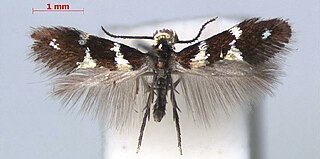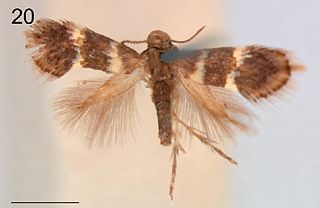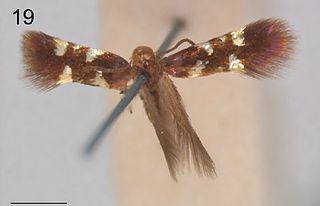
Antispila oinophylla is a species of moth of the family Heliozelidae. It is found in North America, including Ontario, Quebec, Connecticut, Georgia, Kentucky, New York, Tennessee and Vermont. Records under Antispila ampelopsifoliella from Maine, Missouri and Ohio may also partly refer to this species. In Europe, it is introduced into northern Italy.

Antispila voraginella is a species of moth of the family Heliozelidae. It is found in the Rocky Mountains, including Utah, Arizona and western Texas.

Antispila viticordifoliella is a species of moth of the family Heliozelidae. Research suggests that two species might be involved under this name, one feeding on Vitis species which is found in Kentucky and Pennsylvania and the other on Parthenocissus species, which is found in Ontario, Connecticut, Florida, New York and Vermont.

Antispila isabella is a species of moth of the family Heliozelidae. It is found in Ontario, Connecticut, Georgia, Kentucky, New York, Pennsylvania and Vermont. However, research concludes that a complex of species is involved under this name.

Holocacista rivillei is a species of moth of the family Heliozelidae. It is found in southern Europe and western and Central Asia. Records include Spain, France, Italy, Malta, Slovenia, Croatia, Bulgaria, Greece, Sicily, Turkey, south-eastern Russia, Georgia, Kazakhstan, Uzbekistan and Turkmenistan.

Antispila is a moth genus of the family Heliozelidae. It was described by Jacob Hübner in 1825.
Antispila ampelopsia is a moth of the family Heliozelidae. It was described by Kuroko in 1961. It is found in Japan.

Heliozela anna, the jamun leaf miner, is a moth of the family Heliozelidae. It was described by Thomas Bainbrigge Fletcher in 1920. It is found in India, including Bengal.
Antispila argentifera is a moth of the family Heliozelidae. It was described by Annette Frances Braun in 1927. It is found in North America, including Ontario.

Antispila argostoma is a moth of the family Heliozelidae. It was described by Edward Meyrick in 1916. It is found in India.

Antispila aristarcha is a moth of the family Heliozelidae. It was described by Edward Meyrick in 1916. It is found in India.
Antispila aurirubra is a moth of the family Heliozelidae. It was described by Annette Frances Braun in 1915. It is found in the US state of California.
Antispila eugeniella is a moth of the family Heliozelidae. It was described by August Busck in 1900. It is found in the US state of Florida.
Antispila freemani is a moth of the family Heliozelidae. It was described by J. Donald Lafontaine in 1973. It is found in North America, including Ontario and British Columbia.
Antispila inouei is a moth of the family Heliozelidae. It was described by Kuroko in 1987. It is found in Japan.
Antispila isorrhythma is a moth of the family Heliozelidae. It was described by Edward Meyrick in 1926. It is found in India.
Holocacista pariodelta is a moth of the family Heliozelidae. It was described by Edward Meyrick in 1929. It is found in India.

Holocacista selastis is a moth of the family Heliozelidae. It was described by Edward Meyrick in 1926. It is found in India.
Antispila tateshinensis is a moth of the family Heliozelidae. It was described by Kuroko in 1987. It is found in Japan.
Antispila kunyuensis is a moth of the family Heliozelidae. It is found in China.





